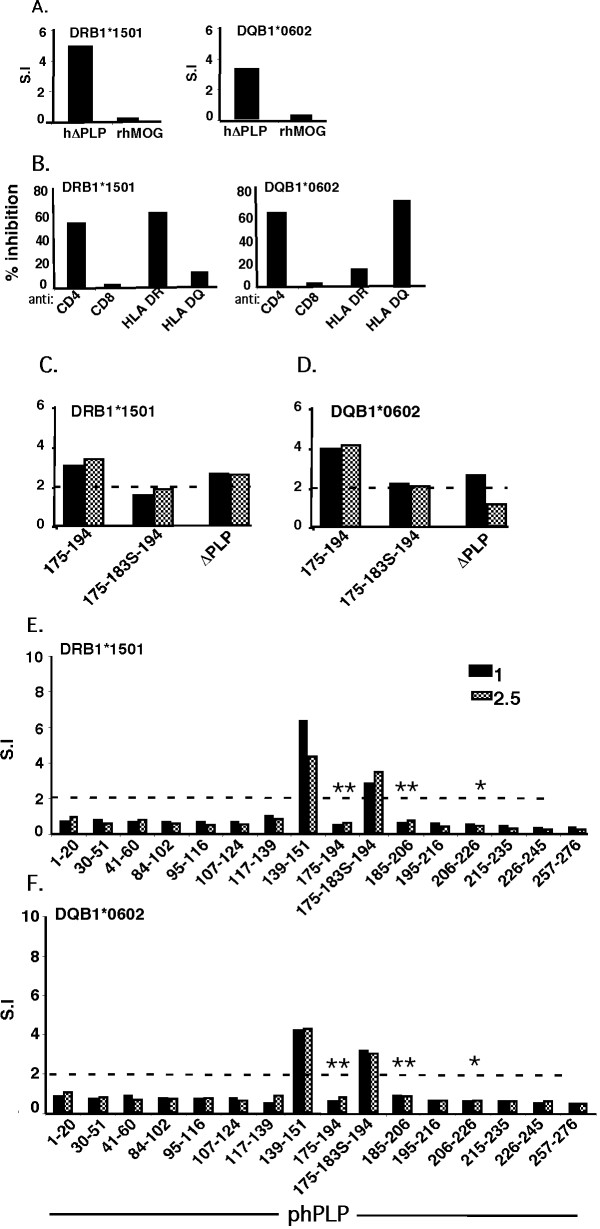Figure 3.
Epitope-specificity of hΔPLP -primed T-cells. (A) Immunogenicity of hΔPLP in DRB1*1501- and DQB1*0602-Tg mice. HLA-Tg mice (two mice per Tg line) were immunized (s.c.) with 200 μg of hΔPLP in CFA. LNCs from draining LNs obtained 10 later were analyzed ex-vivo for their recall proliferative reponse to 5 μg/ml of hΔPLP or to hMOG (as control recombinant protein). Results (S.I.) are from pooled lymphocytes of each immunized HLA-Tg line. (B) HLA-class II restriction of hΔPLP primed LNCs. DRB1*1501- and DQB1*0602-hΔPLP-primed lymphocytes from (A) were analyzed in-vitro for their recall prolifrative response to hΔPLP in the absence or presence of blocking mAb specific for mouse CD4 (Leaf ™Purified anti-mouse CD4), CD8 (Leaf™ purified anti-mouse CD8a), or specific for human HLA-DR (L243) or HLA-DQ (L2) class-II molecules, or respective isotype control Abs.% inhibition - the S.I. calculated for the recall proliferative response in the presence of neutralizing Abs was divided by the S.I. of the response in the absence of neutralizing Abs (×100). (C, D) Antigenicity of mutated PLP175-194 peptide (PLP175-183S-194). DRB1*1501 (C) - and DQB1*0602 (D)- Tg mice (two mice/group) were immunized with 200 μg phPLP175-194 in CFA. Cells from draining LNs obtained 10 days later were analyzed ex-vivo for their recall proliferative response to 1 or 2.5 μg/ml of native phPLP175-194, PLP175-183S-194 mutant peptide, or hΔPLP. The proliferative response was measured as described in Methods. Results (S.I.) are from pooled lymphocytes of immunized HLA- Tg mice. (E, F) Ex-vivo analysis of immunodominant epitopes. Tg mice (two mice per HLA-Tg line) were immunized with 200 μg of in CFA at the flank, as described in Methods for the induction of EAE (protocol 2). Spleen cells were obtained from each of the immunized mice on day 14 after immunization and cultured in vitro in triplicates in the absence or presence of 1 or 2.5 μg/ml of each of the overlapping peptides (derived from native hPLP) spanning the hΔPLP, and in the presence of PLP175-183S-194 mutant peptide. Results are the mean S.I. of two individual spleens from mice immunized with same peptide in each HLA-Tg line. Results obtained from another independent experiment that was carried out in the same manner showed a similar pattern of reactivity to the overlapping peptides. *, and **, represent native PLP peptides, the cysteines of which were replaced by serine in the hΔPLP, where *, depicts peptides containing Cys within the nonameric core epitope for DRB1*1501 and/or DQB1*0602 molecule, but is not a major TCR or MHC binding residue, as predicted in silico: and **, depicts peptides containing Cys in the nonameric core epitope for DRB1*1501 and/or DQB1*0602 molecule that was predicted in silico to be a major TCR-contact or MHC-contact residue.

